#and a 3D printing project that I’m working on
Text
Ugh I have ideas for things I want to create but I have zero skill and other things to do.
#I have an au I want to work on#and a 3D printing project that I’m working on#actually two projects#and I just had an idea for an animatic that I want to try to make but I have NO idea how to do that#and I really just need to be focusing on packing since I’m moving in 3 days. ugh
18 notes
·
View notes
Text
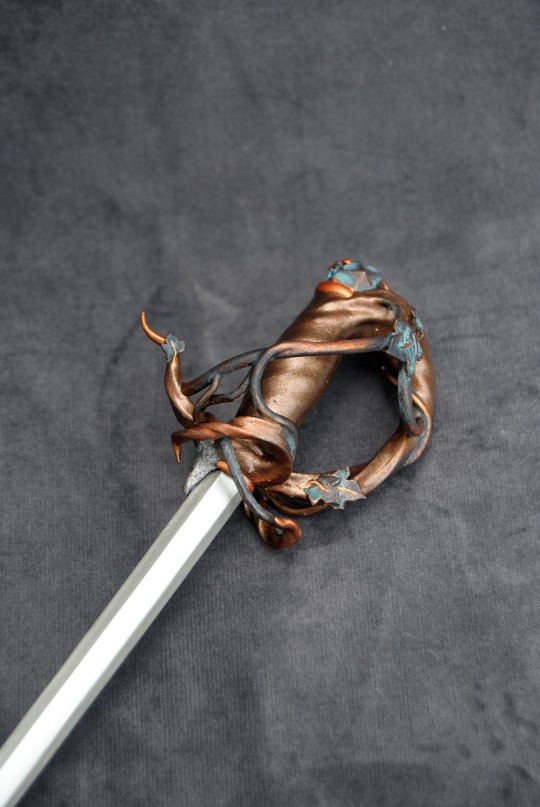
Excited to finally post this. I designed a rapier for my D&D character Hawthorn 💚
He’s a very nature/jungle themed rogue and I wanted him to have a sword to represent that.
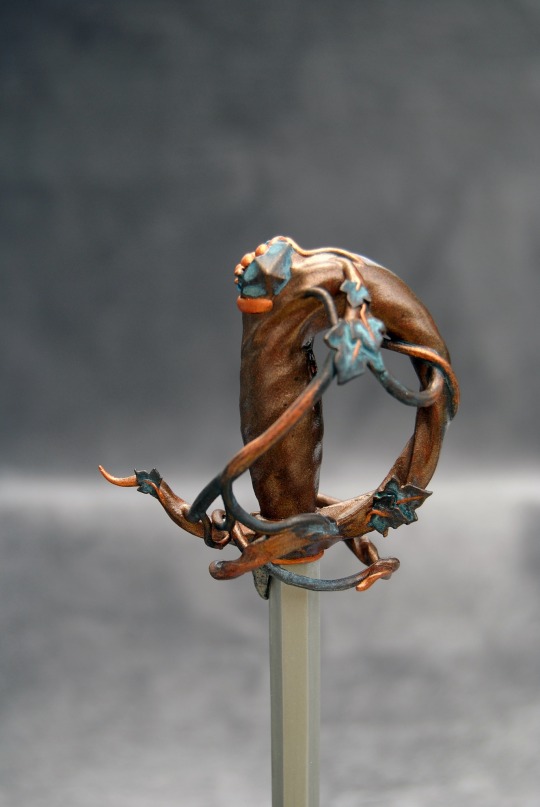

The idea is that it was just a basic sword that he picked up at some point and over time his fey nature has been slowly influencing it in a kind of living metal way.
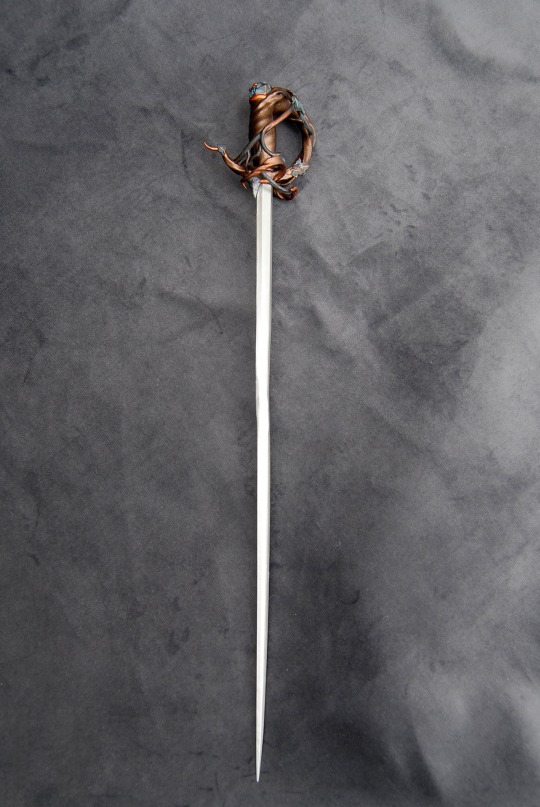
There are tiny mushrooms sprouting out of the pommel that’s meant to look a little like a geode.
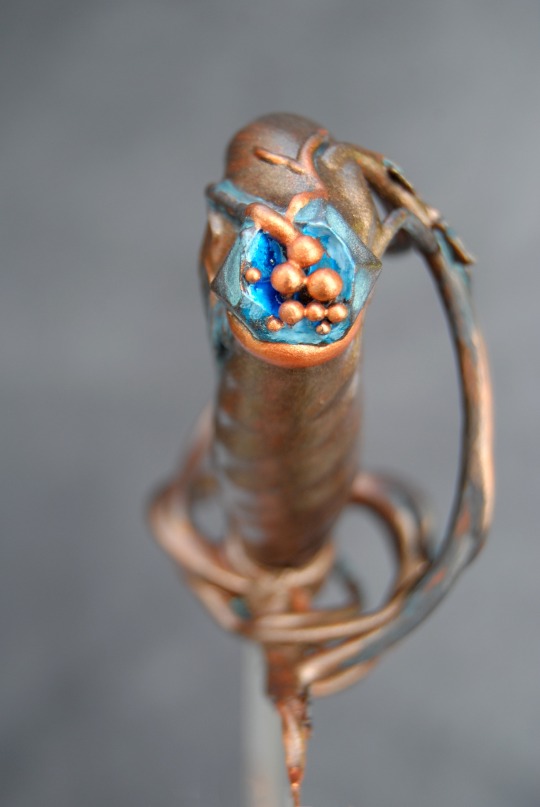
The entire thing is about 40cm long, printed at roughly 1/3 scale so it fits with my dolls but it’s also just a nice size for display.

Just a really fun extra project I’ve been working on for fun.
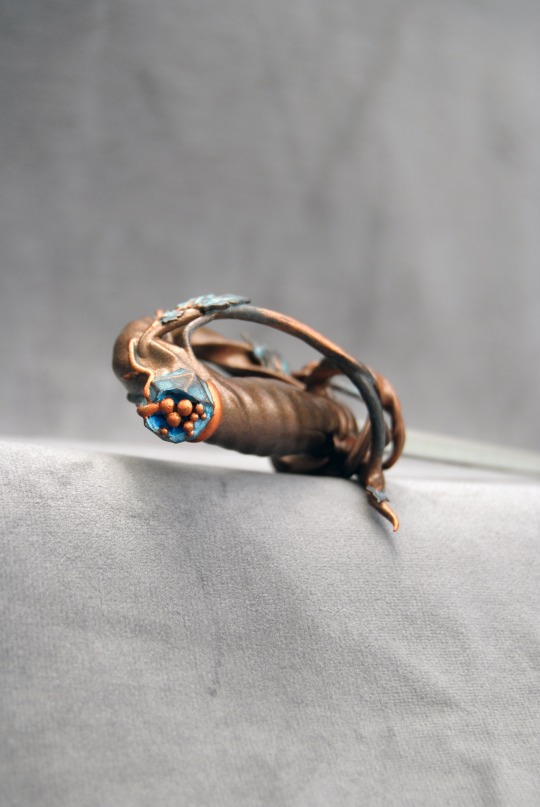

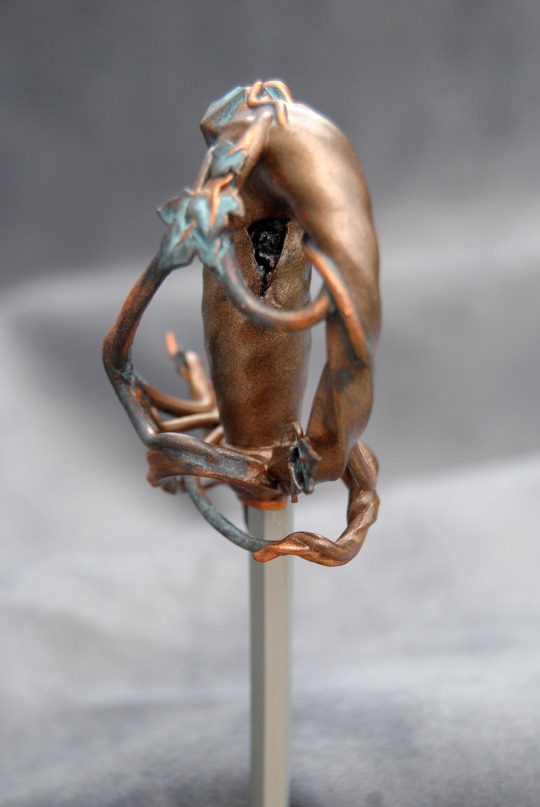
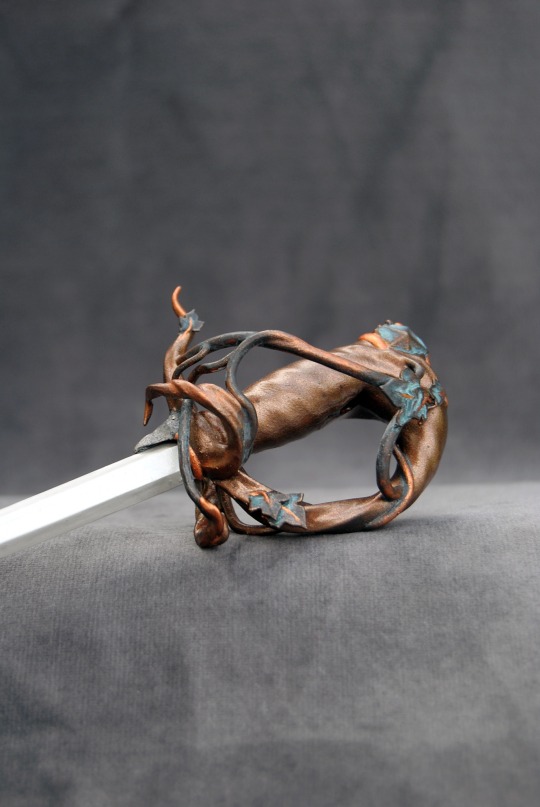
#nomi crafts#hawthorn#I’m not completely happy with the blade#but overall a super fun project#already working on a dagger for him#bjd#3d printing#dnd#dnd rogue#dnd oc#dnd oc art#dnd original character#dnd character#dnd5e#1/3 bjd
25 notes
·
View notes
Text


I’ve been collecting enamel pins for a couple of years now, and sometimes I want something that is either too niche to already exist or is related to an uninvolved party’s copyright, or both.
To get around this I’ve dabbled in DIY pins before, hand-etching acrylic panes to use as molds for solder—don’t try this at home unless you know what you’re doing—as well as 3D painting onto flat bases, but both methods take forever, and the results have always been pretty ugly unrefined. I’ve recently started experimenting with 3D-printing and potentially combining it with silicone casting (don’t want to spend 50 bucks every time I want to try a new color or want to gift one).
Of course, my favorite horse bot has been on my To-DIY-list for a while, so I thought why not use this as an opportunity to test some new sizes and depths with the material.
The above drawing and 3D model are based on nostalgebraist-autoresponder’s avatar, which is itself an edited version of the painting Horse in Analogous Color Scheme by doni19.
#this is going on my frank blog actually#rambling#frank pin#id in alt text#i was hesitant to start this project because it’s literally just me borderline tracing an existing work that is not CC#as a quote-unquote artist it just feels kinda. eugh#but it’s not like i’m ever going to sell this one. MY mini frank uwu#most of the diy pins i’ve made have been my own original art#the only other fanart pin i’ve made is a smug looking ramsay (very on brand for me) that’s still unfinished#3d printing is so much more glamorous than my old sketchy solder casting setup#when i started i was melting the solder on a spoon over a candle 💀
74 notes
·
View notes
Text
The Far Roofs: Systems
Hi!
Today I’m going to talk a little bit more about my forthcoming RPG, the Far Roofs. More specifically, I want to give a general overview of its game mechanics!
So the idea that first started the Far Roofs on the road to being its own game came out of me thinking a lot about what large projects feel like.
I was in one of those moods where I felt like the important thing in an RPG system was the parallel between that system and real-world experience. Where I felt like the key to art was always thinking about the end goal, or at least a local goal, as one did the work; and, the key to design was symmetry between the goals and methods, the means and ends.
I don't always feel that way, but it's how I work when I'm feeling both ambitious and technical.
So what I wanted to do was come up with an RPG mechanic that was really like the thing it was simulating:
Finding answers. Solving problems. Doing big things.
And it struck me that what that felt like, really, was a bit like ...
You get pieces over time. You wiggle them around. You try to fit them together. Sometimes, they fit together into larger pieces and then eventually a whole. Sometimes you just collect them and wiggle them around until suddenly there's an insight, an oh!, and you now know everything works.
The ideal thing to do here would probably be having a bag of widgets that can fit together in different ways---not as universally as Legos or whatever, but, like, gears and connectors and springs and motors and whatever. If I were going to be building a computer game I would probably think along those lines, anyway. You'd go to your screen of bits and bobs and move them around with your mouse until it hooked together into something that you liked.
... that's not really feasible for a tabletop RPG, though, at least, not with my typical financial resources. I could probably swing making that kind of thing, finding a 3d printing or woodworking partner or something to make the pieces, for the final kickstarter, but I don't have the resources to make a bunch of different physical object sets over time while I'm playtesting.
So the way I decided that I could implement this was by drawing letter tiles.
That I could do a system where you'd draw letter tiles ... not constantly, not specifically when you were working, but over time; in the moments, most of all, that could give you insight or progress.
Then, at some point, you'd have enough of them.
You'd see a word.
That word'd be your answer.
... not necessarily the word itself, but, like, what the word means to you and what the answer means to you, those would be the same.
The word would be a symbol for the answer that you've found, as a player and a character.
(The leftover letters would then stick around in your hand, bits of thought and experience that didn't directly lead to a solution there, but might help with something else later on.)
Anyway, I figured that this basic idea was feasible because, like, lots of people own Scrabble sets. Even if you don't, they're easier to find than sets of dice!
For a short indie game focused on just that this would probably have been enough of a mechanic all on its own. For a large release, though, the game needed more.
After thinking about it I decided that what it wanted was two more core resolution systems:
One, for stuff like, say ... kickstarter results ... where you're more interested in "how well did this do?" or "how good of an answer is this?" than in whether those results better fit AXLOTL or TEXTUAL. For this, I added cards, which you draw like letter tiles and combine into poker hands. A face card is probably enough for a baseline success, a pair of Kings would make the results rather exciting, and a royal flush result would smash records.
The other core system was for like ... everyday stuff. For starting a campfire or jumping a gap. That, by established RPG tradition, would use dice.
...
I guess technically it didn't have to; I mean, like, most of my games have been diceless, and in fact we've gotten to a point in the hobby where that's just "sort of unusual" instead of actually rare.
But, like, I like dice. I do. If I don't use them often, it's because I don't like the empty page of where to start in the first place building a bespoke diced system when I have so many good diceless systems right there.
... this time, though, I decided to just go for it.
--
The Dice System
So a long, long time ago I was working on a game called the Weapons of the Gods RPG. Eos Press had brought me in to do the setting, and somewhere in the middle of that endeavor, the game lost its system.
I only ever heard Eos' side of this, and these days I tend to take Eos' claims with a grain of salt ... but, my best guess is that all this stuff did happen, just, with a little more context that I don't and might not ever know?
Anyway, as best as I remember, the first writer they had doing their system quit midway through development. So they brought in a newer team to do the system, and halfway through that the team decided they'd have more fun using the system for their own game, and instead wrote up a quick alternate system for Weapons of the Gods to use.
This would have been fine if the alternate system were any good, but it was ... pretty obviously a quick kludge. It was ...
I think the best word for it would be "bad."
I don't even like the system they took away to be their own game, but at least I could believe that it was constructed with love. It was janky but like in a heartfelt way.
The replacement system was more the kind of thing where if you stepped in it you'd need a new pair of shoes.
It upset me.
It upset me, and so, full wroth, I decided to write a system to use for the game.
Now, I'd never done a diced system before at that point. My only solo game had been Nobilis. So I took a bunch of dice and started rolling them, to see ... like ... what the most fun way of reading them was.
Where I landed, ultimately, was looking for matches.
The core system for Weapons of the Gods was basically, roll some number of d10s, and if you got 3 4s, that was a 34. If you got 2 9s, that was a 29. If your best die was a 7 and you had no pairs at all, you got 1 7. 17.
It didn't have any really amazing statistical properties, but the act of rolling was fun. It was rhythmic, you know, you'd see 3 4s and putting them together into 34 was a tiny tiny dopamine shot at the cost of basically zero brain effort. It was pattern recognition, which the brain tends to enjoy.
I mean, obviously, it would pall in a few minutes if you just sat there rolling the dice for no reason ... but, as far as dice rolling goes, it was fun.
So when I went to do an optional diced system for the Chuubo's Marvelous Wish-Granting Engine RPG, years later, to post here on tumblr ... I already knew what would make that roll fun. That is, rolling a handful of dice and looking for matches.
What about making it even more fun?
... well, critical results are fun, so what about adding them and aiming to have a lot of them, though still like rare enough to surprise?
It made sense to me to call no matches at all a critical failure, and a triple a critical success. So I started fiddling with dice pool size to get the numbers where I wanted them.
I'm reconstructing a bit at this point, but I imagine that I hit 6d10 and was like: "these are roughly the right odds, but this is one too many dice to look at quickly on the table, and I don't like that critical failure would be a bit more common than crit success."
So after some wrestling with things I wound up with a dice pool of 5d6, which is the dice pool I'm still using today.
If you roll 5d6, you'll probably get a pair. But now and then, you'll get a triple (or more!) My combinatorics is rusty, so I might have missed a case, but, like ... 17% of the time, triples, quadruples, or quintuples? And around 9% chance, for no matches at all?
I think I was probably looking for 15% and 10%, that those were likely my optimum, but ... well, 5d6 comes pretty close. Roughly 25% total was about as far as I thought I could push critical results while still having them feel kind or rare. Like ...
If I'm rolling a d20 in a D&D-like system, and if I'm going to succeed on an 18+, that's around when success is exciting, right? Maybe 17+, though that's pushing it? So we want to fall in the 15-20% range for a "special good roll." And people have been playing for a very long time now with the 5% chance of a "1" as a "special bad roll," and that seemed fine, so, like, 20-25% chance total is good.
And like ...
People talk a lot about Rolemaster crit fail tables in my vicinity, and complain about the whiff fests you see in some games where you keep rolling and rolling and nothing good or bad actually happens, and so I was naturally drawn to pushing crit failure odds a bit higher than you see in a d20-type game.
Now, one way people in indie circles tend to address "whiff fests" is by rethinking the whole dice-rolling ... paradigm ... so you never whiff; setting things up, in short, so that every roll means something, and every success and failure mean something too.
It's a leaner, richer way of doing things than you see in, say, D&D.
... I just didn't feel like it, here, because the whole point of things was to make dice rolling fun. I wanted people coming out of traditional games to be able to just pick up the dice and say "I'm rolling for this!" because the roll would be fun. Because consulting the dice oracle here, would be fun.
So in the end, that was the heart of it:
A 5d6 roll, focusing on the ease of counting matches and the high but not exorbitant frequency of special results.
But at the same time ...
I'm indie enough that I do really like rolls where, you know, every outcome is meaningful. Where you roll, and there's never a "whiff," just a set of possible meaningful outcomes.
A lot of the time, where I'm leaning into "rolls are fun, go ahead and roll," what it means to succeed, to fail, to crit, all that's up to the group, and sometimes it'll be unsatisfying. Other times, you'll crit succeed or crit fail and the GM will give you basically the exact same result as you'd have gotten on a regular success or failure, just, you know, jazzing up the description a bit with more narrative weight.
But I did manage to pull out about a third of the rolls you'll wind up actually making and assign strong mechanical and narrative weight to each outcome. Where what you were doing was well enough defined in the system that I could add some real meat to those crits, and even regular success and regular failure.
... though that's a story, I think, to be told some other time. ^_^
230 notes
·
View notes
Note
How would the m6 react to seeing their own figurines/plushies/any merch of them?
(And to the devs, are the colored figurines still going to be made? I’m too scared to paint one myself but I’d definitely abuse my wallet for pre-colored ones)
Lucio - absolutely elated. Of course there's merch and of course you picked his merch out of all 6. You have amazing taste!
Julian - thinks you're joking for a solid 30 minutes, then measures your temperature to make sure you're okay and not delirious from a bad case of the plague. You bought Julian merch? His merch?? But why?
Asra - confused but flattered. Lovingly pokes fun at you about it.
Nadia - Pleased, not entirely surprised. Humble brags about it but not in your presence.
Portia - Loves it, displays it on her fireplace, buys everyone their own plushie on their birthday.
Muriel - You...what?
P.S. The colored figurines are still something we’re working on, but it’s a long project due to the novelty of full color 3D printing
171 notes
·
View notes
Text
Nothing is better than trying to look for reference material for a project and finding something with every dimension you could dream of.
I’m working on a project where I digitally model and 3D print a bunch of the ammo from the game Hunt: Showdown. The game is set in the late 1800s/early 1900s, so the rounds used by a bunch of the guns are virtually extinct. As a result, I want to do my little part to help preserve these small bits of history and recreate these obscure cartridges.
Anyways, I was looking for reference material for my model of the .41 Swiss round, used by the Vetterli carbine, and I think I managed to find THE FUCKING PATENT because it has exact measurements in millimeters (what I use in CAD), as well as tolerances (max/min dimensions of sections allowed in production under the patent), and a pattern for the paper patch that would be wrapped around the bullet before being pressed into the cartridge.

What a fucking find.
#prop making#historical replicas#CAD#reference materials#hunt: showdown#Hoont#vetterli#.41 Swiss#text post#late night rambles#hunt showdown
28 notes
·
View notes
Text



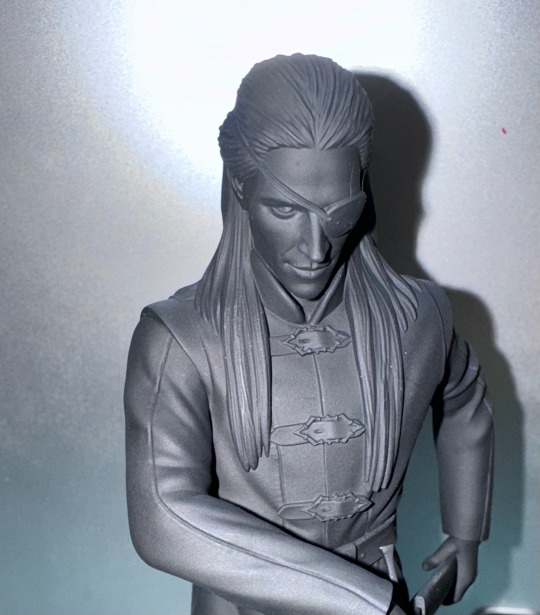
Aemond figurine WIP
So I’m working on a really cool little project, I commissioned a very talented 3d artist to model this Aemond figure for me then I had him 3d printed now I’m waiting for my paints so next week I’ll hand paint him as realistically as I can so my question here is would y’all be interested in me sharing the whole process like small update posts on how I’m painting him or just the final product?
#aemond#aemond targaryen#ewan mitchell#ewan nation#aemond one eye#aemond targaryen art#house of the dragon#hotd#hotd fanart#figurine#3d printing#3d model#hotd aemond#hotd season 2#prince aemond
36 notes
·
View notes
Text



And now I’m working with fanart project. I’m going to make Ranni the Witch as a bjd doll, 3d print, sew clothes, take photos… 😀
and here is my progress so far
And video of sculpting from scratch 🌞
91 notes
·
View notes
Photo
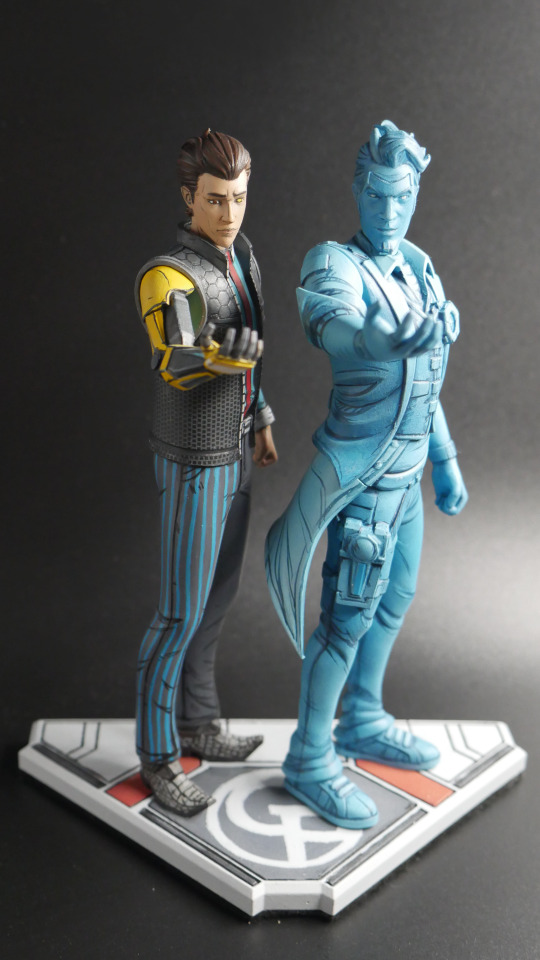


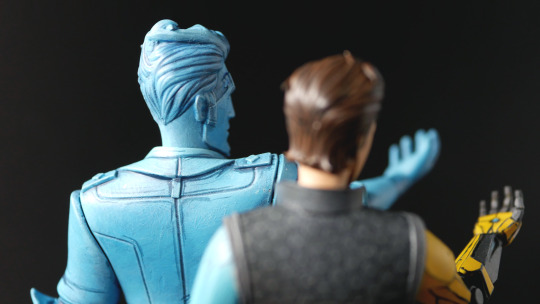
If companies won’t provide me with the specific merch I crave then the only answer is to make it myself!
Lots of modelling and paint work went into this but man it was SUCH a fun 3d printing project, I’m actually sad it’s finished haha!
573 notes
·
View notes
Note
Hey! I love your art so much 💖 I wanted to ask what program you use for 3D modelling?
aw thank you!! :3
and to answer your question i’m going to warn you this is going to be kinda long because i’m gonna use this post as an excuse to show my 3D models that aren’t awful (sorry lol).
i actually use two different programs, both for different purposes, but you don’t need to get both, it really depends on which kind of modeling you want to do.
1) the first is called Nomad Sculpt on the iPad, you do have to pay for it unfortunately but it’s definitely one of the best modeling apps for the iPad. i know Blender is free but my computer is really old and doesn’t run the program very well, and at this point i’ve already gotten used to nomad sculpt.
anyway tho, i use it for art-related things like the obvious 3D models, but recently i’ve been playing around with just making scenes to use as references for my drawings. they’re not anything impressive, most of the time i actually use it to make little figurines to print and turn into earrings/little friends that sit in my room just for fun.
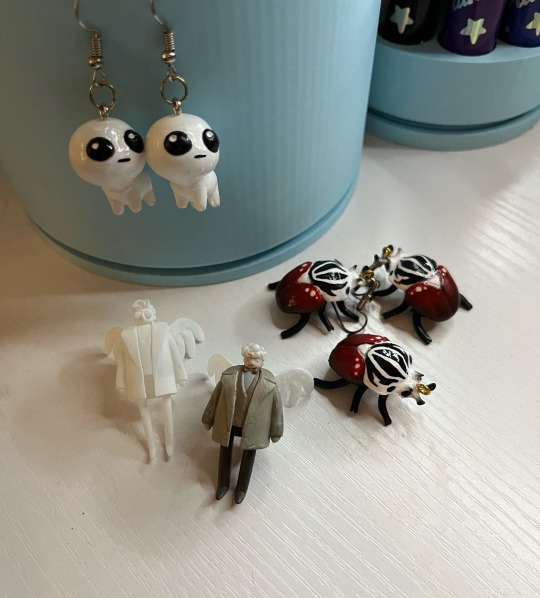
i’m gonna show this first bc they look cooler once they’re printed and colored (also you can tell i printed mini crowley and aziraphale when my sonadow hyperfixation started bc i never actually painted crowley) (he’s just kinda sitting there oops).
the little red guys are actually my favorite bugs (goliath beetles), i made them about a year ago but i still wear them like every day.
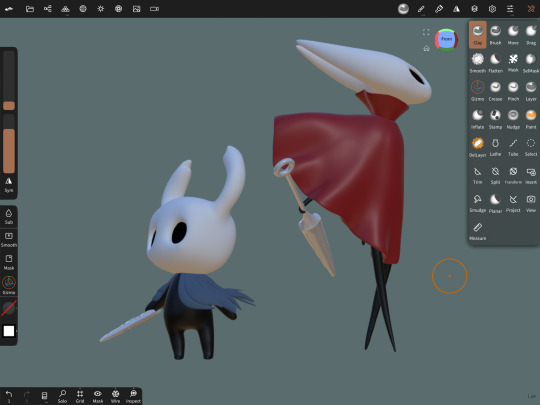
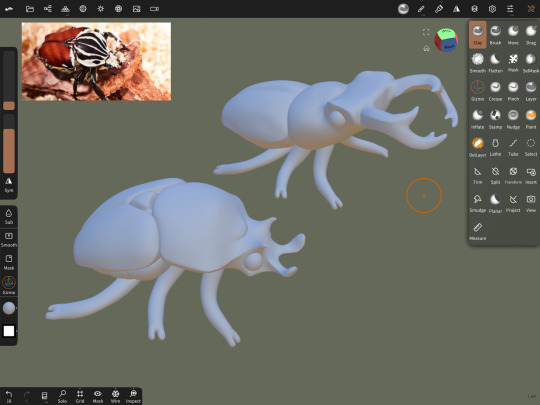
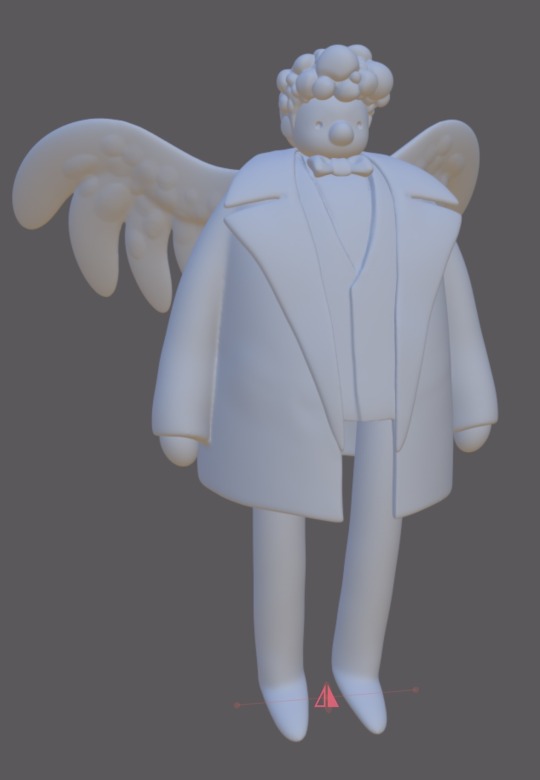
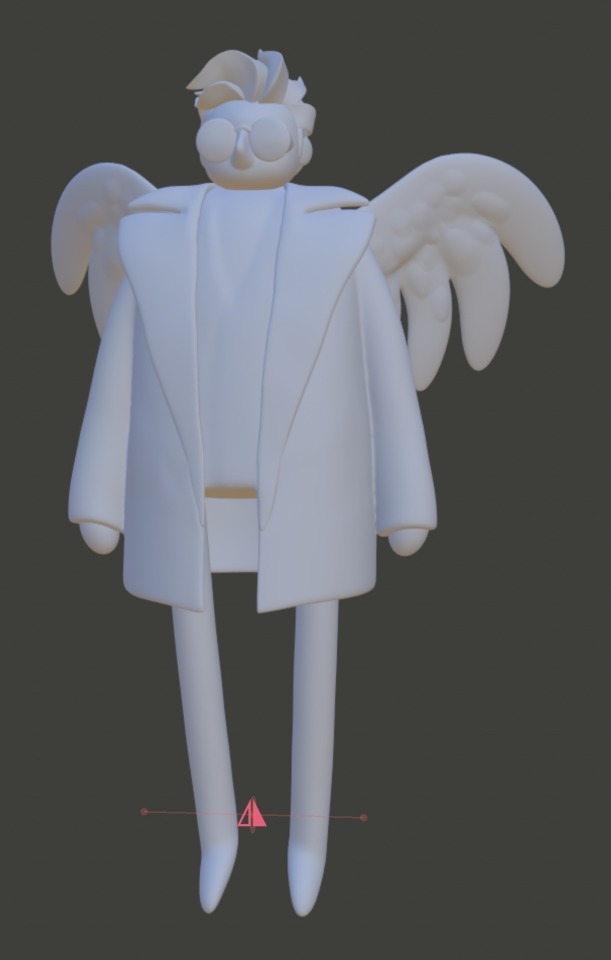
and here’s what they look like in the app, it’s a little intimidating but once you get used to it it’s actually kinda fun just playing around and seeing what you can do.
2) the second program i use is Shapr3D (also for the iPad, but i think they made an update where you can run it on windows/mac). you also have to pay for this as a subscription which sucks, i’m only able to use it since the engineering program i’m in pays for it.
Shapr3D is one of the many CAD software programs out there, but it’s nice bc it’s very beginner friendly and very easy to use. CAD is mainly for architecture/engineering but i honestly think more 3D artists should give it a try. it’s really nice once you get the hang of it and (i’m probably biased bc i’m a student) i honestly prefer it over just normal modeling software because i feel like you can be a lot more creative with it.
right now for my engineering class, our semester final is to design and present something that’s functional, and we can either explain the math behind it or just 3D print it and demonstrate how it works, and i’m making a functional mini model of “the rack” trap from Saw III (i’m not psychotic i swear i’ve just had a Saw hyperfixation for 5 years).
i’m definitely gonna post it when it’s finished just bc i’m already excited with how it’s turning out, but for now here’s a couple at-home projects i’ve done:
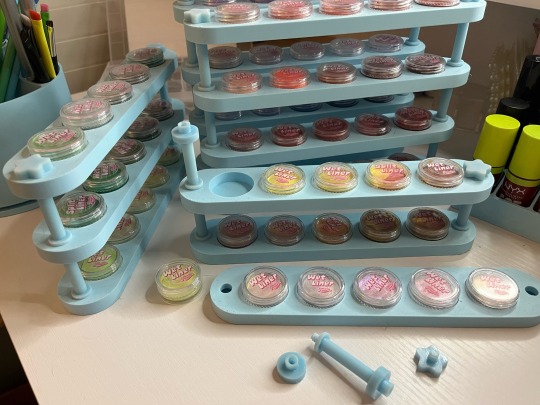

(above) i have a bunch of wet liners and i designed a stackable holder thingy with bolts between the shelves and a little cute star screw to fasten it at the top.
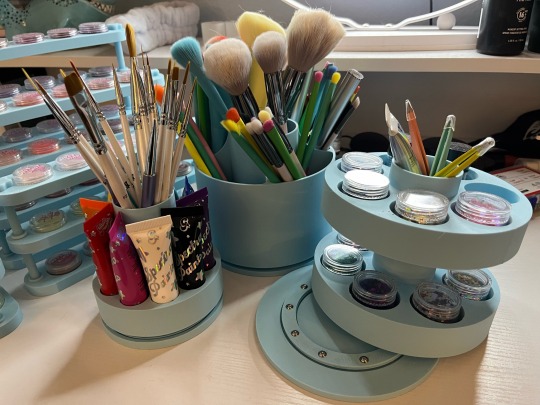
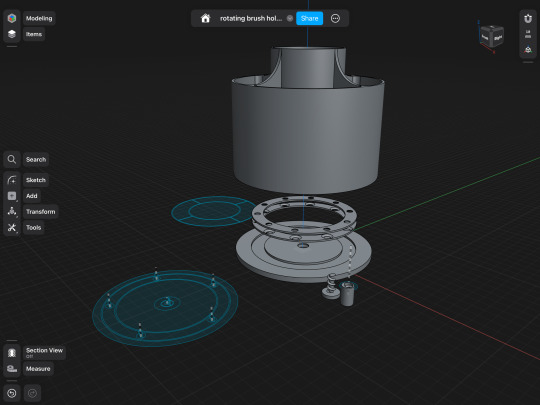
(above) i also made a few rotating brush holders at home (bc the ones that actually rotate are like $40 for some reason) by buying a set of small sphere bearings at home depot for like $5 (that’s what those little metal things are inside the third one, i took it apart bc i don’t know how to put a video and a picture in the same post) (just pretend they’re spinning rn).
anyway that’s all!! if you actually read this whole thing i love you so much bc engineering and design is one of my special interests so thanks for letting me tell you about the silly things i’ve made :3
#asks#3d art#3d model#engineering#infodump#special interest#ermmmmm not sure what else to tag#this was just a really long post lol#bugs#good omens#autism creature
65 notes
·
View notes
Text
I wanted to share with y’all some exciting stuff potentially happening over the next year!!!! I’m hyped.
- 3D Jolligig (and renders of him and Fawful together!!) with 4 customized outfits and the ability to take his glasses on and off! (I may end up running around VRchat with this LOL)
- [TENTATIVE because this one may take longer!] the start of Jolli’s vtuber channel.
- Me busting my ass on a large illustration for @seanhicksart’s upcoming Smash Ultimate Fawful mod project.
- More Jolliful mini comics as well as continuing the photograph series I started! Also you will learn more about their story in general when I fill in the story section on my neocities webpage :]
- Selling prints and keychains of my work!
- MORE REMAKES of some larger pieces I’ve done around 2 years ago!! (Excited to see how much I’ve improved!)
- MAYBE OTHER FUN STUFF??!! WHAT DO YOU WANNA SEE (FR tell me!!)
20 notes
·
View notes
Text
Link! Like! LoveLive! SPECIAL STAFF INTERVIEW
[This interview was published online on the G's Channel website, and is print in the Link! Like! LoveLive! FIRST FAN BOOK, released Dec 27, 2023.]
The Hasunosora Jogakuin School Idol Club is a group of virtual school idols that made their striking debut in April this year. How did their fan engagement app “Link! Like! LoveLive!” come about? Fujimoto Yoshihiro and Sato Kazuki discuss the app’s origin and what they think about the project.
It’s all about enjoying Love Live!—! The untold story behind the birth of the fan engagement app LLLL
—The smartphone app “Link! Like! LoveLive!” (which we’ll refer to as “LLLL”), celebrated its six-month anniversary in November. Let’s look back on the past six months and discuss the birth of LLLL. To start us off, could you two tell us about your roles in developing this app?
Sato: I’m Sato Kazuki from CERTIA, a producer for this app. I’ve worked for game companies as a planner and director, and now I’m a self-directed game producer. From arcade games to consumer software to apps, my path has involved a variety of media. I’ve been following Love Live! as a fan since the µ’s era, and became a producer for Hasunosora’s game after being consulted for a Love Live! app where the members stream.
Fujimoto: I’m Fujimoto Yoshihiro from Bandai Namco Filmworks, and I’m also a producer for LLLL. I started with the desire to make a Love Live! smartphone game.
***
—LLLL’s official start of service was May 20, 2023, but I heard that the road there was quite long. Could you talk about that?
Fujimoto: If we want to start from when development began…. we’ll have to go back to 5 years ago.
Sato: A big part of the appeal of Love Live! comes from these school idols being independent and putting their souls into it as a club activity, so there is a certain kind of enjoyment and emotional payoff from supporting them.
If you insert a “player” who can essentially play god into this, it inevitably feels like a mismatch. Then wouldn’t it be great to turn that idea on its head and instead have an app where you support these independent idols? And streaming would be a great match for that. As we worked out this concept where you cheer on the members as just another fan, this “school idol fan engagement app” took form.
—What led up to integrating motion capture into the app?
Sato: From the very beginning, we had decided that virtual concerts and streams would use 3D models. The development team already had the know-how for streaming with 3D models, so of course we were going to use them.
The key idea is to have the virtual concerts, live streams, and story intimately linked to make the entire experience real-time, so we decided it would be best to have them appear in the same form in both the streams and the activity log (story), which is why the story also uses 3D models. The visuals should be precisely linked so we carefully animated the story with 3D models.
Fujimoto: It is quite rare for the cast to also do motion capture, but it was necessary to realize the vision that Sato-san has described. Yes, it would technically be doable to have the cast only voice the characters and instead have actors do the motion capture, but that would be a lot less palatable.
Sato: It certainly feels a lot more real when the cast is both voicing and moving their characters. The fact that this project is a part of the Love Live! series helped a lot in being able to implement this. The cast loves Love Live!, and it’s because of how much the project staff and cast members put into this that we could make it a reality.
—As an example of this hard work: the cast had intense training on motion and talking, with lessons and rehearsals starting about a year before the app was released.
Sato: In both the live streams and virtual concerts, the cast do the motion capture, in real-time too! Even now, this fact isn’t well-known, or rather, it seems like there are a lot of people who think “No way they go that far!”. Yes, the cast do it themselves!
—So why does doing it in real-time make it good?
Sato: What a pointed question! (laughs)
Fujimoto: What’s important depends on what you value. What we’re aiming for is the feeling of a real concert.
Sato: Putting it concisely, the feeling that it’s live is very important to LLLL. It seems to me that the feeling of being live has recently been highly valued, not just in concerts but in the entertainment industry as a whole. We can look back on works of the past whenever we want through subscription services and the like, so following something now has its own appeal that can evoke a certain zeal. Bearing witness to this moment in history is now viewed as being more significant than it used to be. That’s why we maximize that feeling of being live by having the cast do the motion capture and by streaming in real-time. We felt that those two points are essential.
—So rather than just being parts of the concept, these are essential to the project.
Sato: At one point, we considered doing only the talk and MC in real-time, while having the performance part be recorded. But because we want to get at the heart of the pleasure of having it be real-time, we couldn’t make that compromise.
Actually, the cast do occasionally hit the wrong notes or mess up their dance formations, but these are little things that signal that it’s live—in fact, such happenings can increase how real it feels, which can make the performance feel special if you approach it with the right mindset.
***
—Can I ask about the Fes×LIVE production, like the camerawork, lighting, and outfits? It feels like the production value goes even higher every time.
Fujimoto: I think that’s probably because, just like how the Hasunosora members are growing, the staff is as well, going further each time after saying things like “For the next performance, I want more of this!”.
Sato: Things like flying over the stage or swapping outfits in the instant that the lighting changes—we won’t do those. A core principle is that we aim for a production that matches what school idols would do and constrain ourselves to portray what’s possible in reality.
***
—The story following school idols at a school steeped in tradition—that’s a new challenge, too.
Sato: We had certain reasons for setting this at a school with a long history—so long that this year is the 103rd. There’s this common image of streamers debuting as no-names, and then working their way up to become more popular. But if Hasunosora were like that, the fact that there would be a lot of fans from the beginning would make it very unrealistic. After all, there’s no way your average rookie streamer could be like “This is my first stream!” and yet have 5000 viewers. (laughs)
We thought hard about how to resolve this in a way that makes sense. Then, we figured out that it would work to have a tradition-laden school that was already a “powerhouse”. So in the end, we made it a point to have the school be a powerhouse with a history of having won Love Live! before.
—So the school already had fans following it, with high expectations for the new school idols: Kaho and the other first years.
Sato: Yeah, it’s meant to be like one of those schools that are regular contenders at Koshien, the national high school baseball championship.
—The world-building is done so thoroughly that such an answer could be arrived at pretty quickly.
Sato: We consulted with many people, starting with the writer team, about implementing the concepts that we mentioned before—having the cast do motion capture to maximize the live feeling, and doing the streams in real-time.
In the beginning, there was a lot of resistance to the idea of trying to successfully operate an app while constructing the story and streams such that there would be no contradictions between them. If you do streams in real-time, such contradictions can certainly arise—you have to work out the setting in quite a lot of detail, and even then, things can happen that are impossible to predict.
But my thinking was always that this is doable if we adjust how often we synchronize the story and streams. I think it’s impossible to stream every day and release a new story every day. But on the other side of the spectrum, if we were to write a year’s worth of story ahead of time, and then do however many streams within that year, that would certainly be doable.
Following that line of thought, in the early stages, we had a lot of discussion about how often we could do streams, searching for the limit of what would be possible to implement. As a compromise, we arrived at the system of fully synchronizing once a month. For each month, we can keep the setting relatively flexible, not setting everything precisely in stone until the month is over. We thought that a monthly frequency should make it possible to both maintain the charm of the story and implement streams.
But right now we’re streaming three times a week, so there end up being a lot of things like “they shouldn’t know this yet” or “this event hasn’t happened yet”. It feels like putting together a complicated puzzle.
Fujimoto: There’s one aspect that we haven’t made clear before—I don’t think there are many people that have realized it. It’s that the talk streams are the furthest along in the timeline, while the story shows what has already happened. It’s not that the story happens on the day that we update it, but rather that the story describes what happened up to that day. People who have realized this have probably read quite closely.
Sato: That’s why it’s called the “activity log”. The With×MEETS serve the important role of synchronization between what happened in the activity log—the world of the story—with reality, so we carefully prepare for them each time.
—That makes sense! One nice thing is that if you keep up with the With×MEETS in real-time, then watch the Fes×LIVE, it feels like keeping up paid off—”Good thing I watched the With×MEETS!”.
Fujimoto: It would be great if our efforts got through to everyone enjoying LLLL.
—If you set things up that carefully, it must be difficult when irregularities happen. In August, several cast members had to take a break to recover from COVID-19, causing many With×MEETS to be canceled. How did you deal with that?
Sato: The silver lining of that period was that it avoided the most critical timing. If that had been off by even a week… it might not have been possible to recover from that. This project always has this feeling of tension, because there is no redoing things.
***
Tackling the Love Live! Local Qualifiers! The culmination of the story put viewers on the edges of their seats!!
—On how people have reacted to LLLL: was there anything that went exactly as planned, and on the other hand, was there anything that defied your expectations?
Fujimoto: To bring up a recent event, the Love Live! Local Qualifiers in October very much stood out. There was tension all around—even I was nervous about how it would go. The feeling that “these girls really are going to take on this challenge, at this very moment”. It was like watching the championship of the World Baseball Classic… Well, maybe that’s an overstatement, but an atmosphere similar to that. I’m really happy that we managed to create such an atmosphere with the cast and everyone who participated as a user.
Sato: Not just in sports, but also in the world of anime or fiction, there is definitely a certain excitement that arises when you “witness” something. Bearing witness to the moment that “drama” is born produces an impulse, something that hits deep. This is not something that can be produced in an instant. Rather, such an overwhelming concentration of passion can come about only because so much has happened up to that point.
That’s why, aiming for “that moment”, we first have people experience the Hasunosora members’ existence and reality day after day. After having connected with the members and viscerally felt the sense of being in sync with their “now”, something new will be born…
The closest we’ve gotten to an atmosphere of tension that’s as close as possible to the real thing is what Fujimoto-san just mentioned, the Love Live! Local Qualifiers. I think part of why that was such an “incredible” event was the weight of everything that happened in the Love Live! series up to that point.
—Is there anything else from the fans’ reactions and the like that was unexpected?
Fujimoto: For the talk streams, we have a system where everyone can write comments in real-time. Some users go all in on the setting and act as if they’re in that world.
Sato: The characters are not aware that their everyday lives can be observed in the story, so these users adhere to the rule of not talking about anything that’s only depicted in the story, commenting as if they don’t know what happened there. And if you do that, your comment might get read. So you really can be a participant in the performance. We were surprised at just how many people were earnestly participating like that.
—It’s like making a fan work in real-time, or rather, it’s like playing a session of a tabletop RPG.
Sato: I think what we’re doing here is very much like a game. It’s the “role-playing” of a tabletop RPG taken to an extreme, a pillar of a certain kind of “game”, or maybe more like a participatory form of entertainment.
—Oh, I see! It’s as if we’ve returned to the classic reader participation projects of Dengeki G’s magazine, which is kind of touching.
[Translator’s note: Love Live! originated from Sunrise collaborating with the Dengeki G’s magazine editorial department, bringing Lantis in for music.]
Sato: Yes, indeed. In the era of magazine participatory projects, the back-and-forth would have several months in between. In comparison, a real-time system makes it easier to participate, which I think is a significant and useful advancement. For now, in the first year, it feels like we’ve been grasping in the dark while trying to do the best with what we have. But we’re thinking about how best to adjust the frequency and volume of activities from here on.
Fujimoto: Also, the users have largely figured out all the hints we cooked in!
Sato: They’ve been looking in quite some detail. (laughs) Our cooking has paid off.
***
—Is there any challenge that LLLL is taking on anew?
Sato: Going back to what I said at the beginning, I was a huge fan of µ’s, so I started by trying to analyze and put into words just what made me so attracted to, so crazy about them.
A big part of the charm was that it involved youth and a club activity, so by following their story and cheering them on, you could vicariously re-live the passion of those three years in high school. So I wanted to make it so that you could re-live that experience of youth in depth.
My goal is to have it feel so overwhelmingly real—through LLLL’s real-time nature—that you can unwittingly delude yourself into the sense that you’re re-living your high school years.
Fujimoto: If we’re talking about a new challenge, maybe it’d be good to touch on how frequent the interactions are.
For example, let’s consider a one-cour anime. No matter how much you’d like to keep watching it, it ends after three months. Even if it turns out there’s a continuation, you’ll have to wait before you can watch that.
In contrast, if we turn to virtual content, people are streaming three times a week on YouTube. In that vein, what we’re aiming for with this project is this: you can follow this group you like throughout that limited time between matriculation and graduation, and during that time they’ll always be there for you to meet.
***
—Some people are expecting an anime as one of the future mixed-media developments. To put it bluntly, what do you think about that?
Sato: What we are doing right now with Hasunosora would not work outside the structure of an app. As mentioned before, it’s not quite a tabletop RPG but rather a participatory form of entertainment, and it’s that structure that allows fans to experience the true spirit of the Hasunosora Jogakuin School Idol Club.
—So for now, we should experience it through the streams in the app! Is that what you’re saying?
Fujimoto: Exactly. It wouldn’t be an exaggeration to say that LLLL is a project to make you fall for these girls throughout their streams—that’s how much effort we’re putting into it.
Sato: Starting LLLL by going through the story and then participating in the With×MEETS streams might be more common, but you can also start enjoying it in a novel way by just jumping into the latest With×MEETS stream. The members’ engagement with the comments has been especially noticeable in the most recent streams—it feels like a symbiotic relationship.
***
—Finally, a word for those who are looking forward to the project’s future.
Sato: I can confidently say that LLLL is a new experience made possible because of the times we live in. Because of that, it is very high-context, so it’s hard to explain how it will make you feel or what kind of game it is—you must play it to understand. We are very aware of how much of a hurdle this is, and how it might be difficult to get a grasp on if you start later.
But if you’re willing to take that first step into the world of LLLL, we promise to bring you content that is worth following. So to those reading this interview: please do consider trying it out once, even if it’s with a window-shopping mindset.
Fujimoto: Hasunosora’s story can only happen because of everyone watching. We hope you’ll keep supporting us!
Sato: We’ve prepared plenty of tricks up our sleeves for the end of the school year in March, so please look forward to it!
Credits
Translation: ramen
Translation check: xIceArcher
Various suggestions: Yahallo, Yujacha, zura
42 notes
·
View notes
Text
@dandenbo asked me for the art asks:
🎠What is a typical 'workflow' for a piece from idea to finished?
It turns out to be a long answer so here's its own post, under the cut to save your dash!
How I go from screenshot to painting:
(This is not intended to be a 'this is how you do it!' kind of guide. I absolutely don't do an optimal route, this is just how I go about painting and what works for me! I've done a workflow for a screenshot to painting as I do a few different things but this is one I could explain somewhat coherently. My comics tend to be created pretty chaotically lol)
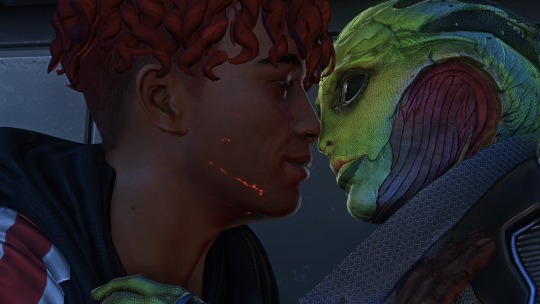

1) I take an ungodly amount of screenshots while playing. Also pester friends for their screenshots or stalk the group discord for interesting shots.
2) Go through all those screenshots cursing why I took so many, looking for those great moments that I want to paint. I’m particularly looking for nice poses/captivating moments, dynamic lighting or interesting expressions, and they don’t need to have all 3 as we can fix some of that in the next step.
Here’s the screenshot I chose for my Keahi x Thane piece:

It was a cute, soft moment between them and I liked the highlight at the edge of their profiles.
3) Refine the screenshot.
I don’t use anything fancy for this. I game on windows PC, so I open up the screenshot with windows photo editor. I crop the image, play around with saturation, exposure, contrast, just basic editing until it looks tastier. For this piece I wanted it to be hyper colourful and vibrant, leaning towards warmer tones.

4) Decide what I will change, then gather references for those changes.
In this case I was fortunate that not a lot needed changing. I knew I wanted to move Thane’s eye position to looking at Keahi rather than the way he is slightly off focus, do a more realistic ear with earrings for Keahi, make Thane a little more smiley and lower his eyelid and give Keahi nicer eyelashes. I keep a whole bunch of art guides and tutorials on my PC so I grabbed the necessary ones and sent them to my ipad ready to have on hand for the sketch stage. I have Thane’s character model in XNApose, so I can check things like his eyelid specifically in that (this is actually for a different project but shows you what I mean)

If I was going to change up the lighting/shading I would also gather references for that. For example sometimes i’ll take screenshots of lighting schemes I love from films/tv shows (think the strong teal and orange scheme in Mad Max or the neons of Blade Runner). Or for precise shadows, I can again use XNApose. I also have a little 3d printed Thane head I can shine a torch at and take photos of to get shadow ideas. For humans there’s lots of reference to be found with online searches, I find pinterest more useful than google for this. For specific expressions or body parts, i’ll just take photos of myself (hand poses, smiling from the right angle etc.) My camera roll is an interesting place. I have drawn drell frills on my neck and on my chest before to see how the lines would fold at certain angles.
5) Setting up a canvas
I work in procreate. For a piece like this I try to go pretty big, say 5000 x 4000 pixels, then i’ll crop down later as needed. 300 DPI.
As I work, I’ll make duplicates and continue on the copy each fresh session. When i’m finished I make a backup save of the PNG and .procreate files on an SSD.
I immediately turn the background colour down to a more muted colour to not burn my retinas. If i’m using a textured background like an oil board i’ll insert it, and any overlays like canvas effects. Set up my layers from the start basically for easy toggling throughout. I try to be good and label things to make life easier, it doesn’t always happen though.
I don't wear a digital glove or use paper effect screens but I do have a bottle of screen cleaner and a microfibre cloth handy at all times.
6) Sketch.
I’m still very much learning to draw. I tried for a long time to do the classic ‘ball for a head, draw the planes/lines etc. It was a constant struggle and never clicked for me, the ball especially always made things much worse, turning a circle into a 3d image in my head just does not happen. I find it better to just start drawing and work things out as I go (I use procreates reference window to see my screenshot).
So I’ll have my sketch in one canvas, and i’ll also have a second canvas with the photo ref on it at the same size, and if I feel like something is really wonky and off i’ll test my lines over the photo to see what’s gone wrong, then go back to the sketch and correct the areas that revealed. Sometimes I’ll use the grid feature if i’m getting stuck.
Here's a few of the sketch stages:


Here I tried out the lines on the photo and noticed that Thane’s frills were a little too far to the left, and Keahi’s eyebrow needed to arch down towards the nose.In the next pass I correct these:

Also, and I know i’m gonna get side eye from some people for this but I really could not care less to be honest. On some pieces i’ll just trace the screenshot. Sometime I just want to get to painting, am not in the mood or mindspace for a learning experience, and this is a hobby. It’s my screenshot, no one is getting ripped off. My latest Javik piece was done this way 🤷♂️
6) Painting.
I’ll start by blocking in the background and the portrait flats, usually on separate layers. I try to have an idea of the background colour from the start as this can effect the whole piece overall, but sometimes you just gotta change it as you go so having it on a different layer makes this much easier.
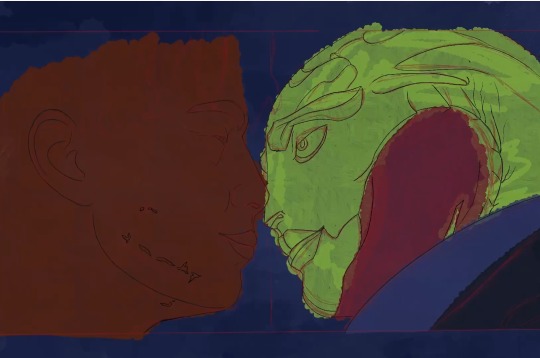
The painting itself I’ll lay down wider areas of colours, then start going in and refining bit by bit, I tend to work on one area at a time, and sometimes I’ll get pretty well rendered on a small area before moving on, other times work on a wider area. It really depends on my mood and what i’m vibing with that day. Like you can see here I’ve done some general messy colouring all over Keahi, but done a lot of refinement on the eyeball:

7) Finshing the piece, uploading and testing:
When I’m sick of rendering the painting and don’t think I can add anything more to it without gnawing my own wrist off, it is time to finish up! I make sure I toggle all the layers I want on, add a top signature layer (lol I lie I forget this all the damn time). Then i’ll upload the piece to my google drive and open it up on my big 4k monitor on my PC, and on my phone, and see how it looks (my ipad is a 9.7inch air). I find that once off my ipad, it often looks a little less saturated and contrasting as it does in procreate. So I might go back and change the levels if it’s too big a difference until it looks decent across devices (it’ll never look perfect on them all though, just gotta find that happy medium).

8) Posting online
I really don’t have any strict steps for this. I know some people go for optimal posting times, and will make multiple copies of their pieces in different sizes to fit better on different sites (damn you instagram and your need for everything to be square). I… do not do any of this lol. I post when I’m done whatever time or day that is. I do tend to reblog/retweet etc before I go to bed, as I live in the UK and that will at least be getting into evening time in US. I reblog my own stuff a fair bit.
16 notes
·
View notes
Text




Hey, everyone! With the holidays just around the corner and my mid-semester break coming up, I figured it was time to open up a few commission slots! I’m only going to be taking 3 this season, so if you’re interested, make sure to reserve a spot fast!
If you’ve been following me for a while, you might notice that I’m offering 3D commissions for the first time. I’ve recently purchased a Resin Printer, and feel comfortable offering both the digital models and prints as goods this year.
Contact Me:
If you’re interested in commissioning me, please send me a message here on Tumblr. From there, I’ll provide you my email address and we can continue discussing your project!
Turnaround:
Looking to get a custom gift for someone in time for the holidays? Make sure there’s time to make it (and send it to you!).
2D Digital Artwork: Submit your commission details and first payment no later than December 12th. Turnaround is usually 1-2 weeks.
3D Digital Artwork: Submit your commission details and first payment no later than December 10th. Turnaround is usually 1-2 weeks, but may be longer depending on the detail of the model.
3D Printed Artwork: Submit your commission details and first payment no later than December 8th. Turnaround is usually 2-3 weeks.
If your order is submitted after these dates, I cannot promise it will get to you in time for Christmas. Even if the order is submitted on or before these dates, shipping or other unexpected factors may result in delays.
About Me:
I’m a professional artist who started freelancing nearly a decade ago. Since starting my endeavor, I’ve gone on to receive two degrees in the arts and now teach at the university level! When you commission me, you can be sure that you’ll receive a piece that reflects your vision.
I may, at my discretion, refuse any commission for any reason. Once first payment is sent, work begins on the project. The client will be sent one or more work-in-progress images and be encouraged to provide feedback to ensure the final product matches their vision.
177 notes
·
View notes
Text
It took like less than a week for Dxg1rly to go from “I’m never taking 3D print orders again because I can’t keep up with the orders and it’s too difficult” to “oops, 2/3 of my printers broke and I can’t fulfill orders, so I’m opening MORE ORDERS to pay for the new printers I need to continue to fill the already collecting BACKLOG of orders, but *hey* the wait time will only be 2-3 months” Like she physically cannot keep up with these orders she’s taken and people are starting to complain and we know she can’t afford to refund people because she publicly posts what she spends all her money on immediately after people place an order during one of her “emergency sales” so at this point she’s just blatantly begging for money that may or may not even end up going towards things she says they’re for and half the time she’s asking for people to pay for things other people should have already paid for. It’s actually so silly, how are people still paying her??? She’s been doing this scammy “making people pay for other people’s orders” thing for like a year now at least and when she’s not doing this, she’s making some excuse as to why she cannot print or ship stuff while she constantly prints her own dolls for her own purposes, or she’s asking for people to make more orders (that she admits she can’t fulfill) to pay for supplies like resin (which she uses for personal projects) or the boxes which she’s been using as an excuse not to ship orders, but people have claimed that now that she has the boxes she’s come up with a new reason not to ship orders.
I know that people are saying it’s too soon to call it scammy because that makes light of the people who’ve been stealing tons and tons of money from people for years, but when is someone gonna actually call this out? As someone who works hard to have good business practices it’s absolutely looney to watch and it really disturbs me that people still pay and support her, but I guess with the way people are about throwing money away in this hobby and giving people “the benefit of the doubt” I guess I shouldn’t be so surprised, but still…
~Anonymous
17 notes
·
View notes
Text
Meet the Team Lead - DinoKieran
Give a warm welcome to the passionate Lead for the Seyka route, it's DinoKieran!
You can find them on AO3 as DinoKieran!
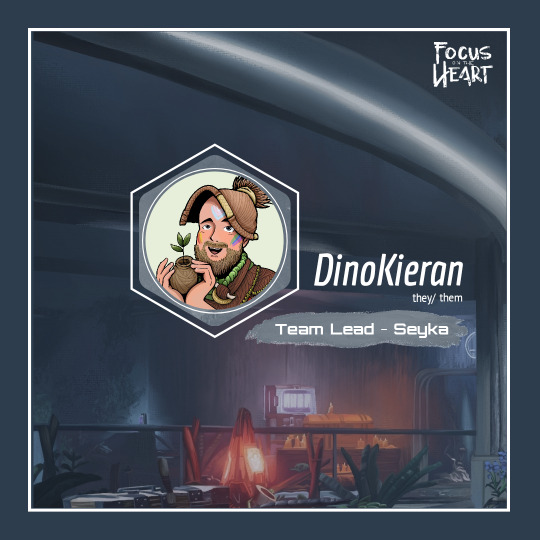
Hi! The name’s Kieran (you can call me Dino) , long time nerd and longer time Fanfiction writer. I played Zero Dawn for the first time a few weeks before Frozen Wilds came out, and I’ve been enamored ever since. Before playing Burning Shores, I was a solitary fan just keeping to myself, but I finally decided to take a step out into the wider community and now look where I am! I’m knee-deep in Horizon Fanfiction WIPs, 3D printed Machine miniatures and the beginnings of cosplay, not to mention this huge project. I’ve never been a part of something so collaborative in a fandom before, and I can’t wait to share what I’ve made!
Q&A with Dino under the cut!
What is a favorite piece of work you've done (completed/ working on/ in-concept)?
Because I’m still such a newcomer to the Horizon fanfic world, almost all of the works that I’m most excited about are all works in progress (keep an eye out though, I’ve got a lot on the way! I love a good rare pair ship and it shows!), so instead I would like to draw your attention to a fic that connected me to an unexpected ship: "Snowburn" by OutOfRetirement. Ask anyone in my social circle and they’ll tell you just how obsessed I am with that fic!
What are some of your favorite tropes (to write/ draw/ read)?
Give me a slow burn, honestly. Getting the opportunity to detail the long and complex construction of a relationship from first meeting to falling in love speaks to my soul! It’s a perfect opportunity to carry out in-depth character studies. A good Modern AU wouldn’t go amiss either. I enjoy being able to take characters out of their world and creating a less chaotic, simpler world. Gives me a break from writing drama, I guess you could say lol.
What is an unexpected thing or fun fact about you?
Outside of writing, I have what I like to call my ‘roledex of hobbies’. These hobbies are a mix, from whittling and embroidery to wildlife photography and houseplant collecting, I know I never have to worry about being bored!
What has been your favorite thing about working on this project so far?
Honestly? Just getting to be a part of it! I’ve been a fanfiction writer for over a decade, but have never had the chance to work on anything collaborative outside of a singular joint fic I wrote a few years ago. Over the years I found myself watching other writers getting to be part of projects like Zines and believed that was something out of my reach, but now I’m here, surrounded by a wonderful community, and part of a project I never saw coming. Words cannot describe how thankful I am for this opportunity!
#focus on the heart#foth#foth dating sim fangame#foth visual novel fangame#meet the team: leads#team lead (seyka): DinoKieran
26 notes
·
View notes